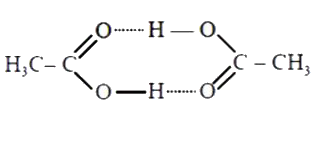H-bonding is the reason for dimerisation of
NO2(s)
BeCl2(s)
CH3COOH(g)
H3BO3(s)
The correct Answer is:C
The following Structure are
Topper's Solved these Questions
Similar Questions
Acetic acid dimerises in benzene solution.The van't Hoff factor for the dimerisation of acetic acid is 0.8. The % of dimerisation of acetic acid is
View SolutionArrange with explanation the following bonds in the increasing order of their bond length and bond energy:
H−H H−F
H−Cl H−Br
H−I
View Solution
Knowledge Check
Assertion : Molecular mass of bezxoic acid when determined by colligative properties is found high.
Reason : Dimerisation of benzene acid.AIf both the assertion and reason are true and reason is a true explanation of the assertion.BIf both the assertion and reason are true but reason is not the correct explanation of the assertionCIf assertion is true but reason is falseDIf assertion is false but reason is true.Assertion : Molecular mass of benzoic acid when determined by colligative properties is found high.
Reason : Dimerisation of benzoic acid.AIf both assertion and reason are true and the reason is the correct explanation of the assertion.BIf both assertion and reason are true but reason is not the correct explanation of the assertion.CIf assertion is true but reason is false.DIf the assertion and reason both are false.Acetic acid dimerises in benzene solution.The van't Hoff factor for the dimerisation of acetic acid is 0.8. The % of dimerisation of acetic acid is
A0.2B0.4C0.6D0.8
Assertion (A) Chlorine reacts more rapidly with H2 in comparison to D2.
Reason (R ) D -CL bond is stronger in comparison to H - Cl bond .
View SolutionAssertion (A) Chlorine reacts more rapidly with H2 in comparison to D2.
Reason (R ) D -CL bond is stronger in comparison to H - Cl bond .
View SolutionThe section contains Assertion and Reason type questions, Each question has 4 choices (1), (2),(3) and (4), out of which only one is correct.
Assertion (A) Among the two O-H bonds in H2O molecule, the energy required to break the first O-H bond and the other O-H bond is the same
Reason (R ) This is because the electronic environment around oxygen undergoes some change after the breakage of one O-H bond.
View SolutionAssertion. C-H bond in ethyne is shorter than C-H bonds in ethene.
Reason. Carbon atom in ethene is sp hybridised while it is sp3 in ethyne.
View SolutionDimerisation of NO2 gives
View Solution
